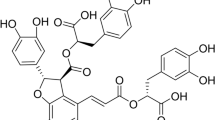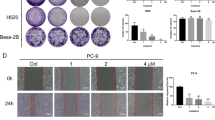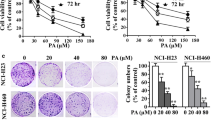Abstract
The non-small cell lung cancer (NSCLC) accounts for about 85% of all lung cancers. It is usually diagnosed at an advanced stage with poor prognosis. Nimbolide (NB), a terpenoid limonoid isolated from the flowers and leaves of neem tree, possesses anticancer properties in various cancer cell lines. However, the underlying mechanism of its anticancer effect on human NSCLC cells remains unclear. In the present study, we investigated the effect of NB on A549 human NSCLC cells. We found that NB treatment inhibits A549 cells colony formation in a dose-dependent manner. Mechanistically, NB treatment increases cellular reactive oxygen species (ROS) level, leading to endoplasmic reticulum (ER) stress, DNA damage, and eventually induction of apoptosis in NSCLC cells. Furthermore, all these effects of NB were blocked by pretreatment with antioxidant glutathione (GSH), the specific ROS inhibitor. We further knockdown CHOP protein by siRNA markedly reduced NB-induced apoptosis in A549 cells. Taken together, our findings reveal that NB is an inducer of ER stress and ROS; these findings may contribute to increasing the therapeutic efficiency of NSCLC.








Similar content being viewed by others
Data Availability
Not applicable.
Abbreviations
- 53BP1:
-
Tumor protein p53 binding protein 1
- ATF4:
-
Activating transcription factor 4
- Bax:
-
Bcl2-associated protein x
- Bcl2:
-
B-cell lymphoma 2
- DCFH-DA:
-
2′,7′-Dichlorodihydrofluorescein diacetate
- DSB:
-
Double-strand break
- EGFR:
-
Epidermal growth factor receptor
- ER:
-
Endoplasmic reticulum
- FITC:
-
Fluorescein isothiocyanate
- GSH:
-
Glutathione
- HRP:
-
Horseradish peroxidase
- MTT:
-
3-(4,5-Dimethylthiazol-2-yl)-2,5-diphenyltetrazolium bromide
- NB:
-
Nimbolide
- NSCLC:
-
Non-small cell lung cancer
- PI:
-
Propidium iodide
- ROS:
-
Reactive oxygen species
- STAT3:
-
Signal transducer and activator of transcription 3
References
Bray, F., Ferlay, J., Soerjomataram, I., Siegel, R. L., Torre, L. A., & Jemal, A. (2018). Global cancer statistics 2018: GLOBOCAN estimates of incidence and mortality worldwide for 36 cancers in 185 countries. CA: A Cancer Journal for Clinicians, 68(6), 394–424.
Siegel, R., Naishadham, D., & Jemal, A. (2013). Cancer statistics, 2013. CA: A Cancer Journal for Clinicians, 63(1), 11–30.
Sakashita, S., Sakashita, M., & Sound Tsao, M. (2014). Genes and pathology of non-small cell lung carcinoma. Seminars in Oncology, 41(1), 28–39.
Vyfhuis, M. A. L., Mohindra, P., & Simone, C. B. (2019). Stereotactic body radiation therapy versus thermal ablation for early stage non-small cell lung cancer. Radiology, 290(2), 574–575.
Stinchcombe, T. E., Fried, D., Morris, D. E., & Socinski, M. A. (2006). Combined modality therapy for stage III non-small cell lung cancer. The Oncologist, 11(7), 809–823.
Zhang, J., Yu, J., Sun, X., & Meng, X. (2014). Epidermal growth factor receptor tyrosine kinase inhibitors in the treatment of central nerve system metastases from non-small cell lung cancer. Cancer Letters, 351(1), 6–12.
Katanasaka, Y., Kodera, Y., Yunokawa, M., Kitamura, Y., Tamura, T., & Koizumi, F. (2014). Synergistic anti-tumor effects of a novel phosphatidyl inositol-3 kinase/mammalian target of rapamycin dual inhibitor BGT226 and gefitinib in non-small cell lung cancer cell lines. Cancer letters, 347(2), 196–203.
(2018). Osimertinib treats CNS metastases in NSCLC. Cancer discovery, 8(11), Of3
Lee, C. K., Davies, L., Wu, Y. L., Mitsudomi, T., Inoue, A., Rosell, R., Zhou, C., Nakagawa, K., Thongprasert, S., Fukuoka, M., Lord, S., Marschner, I., Tu, Y. K., Gralla, R. J., Gebski, V., Mok, T. & Yang, J. C. (2017). Gefitinib or erlotinib vs chemotherapy for EGFR mutation-positive lung cancer: Individual patient data meta-analysis of overall survival. Journal of the National Cancer Institute, 109(6)
Zhou, C., Wu, Y. L., Chen, G., Feng, J., Liu, X. Q., Wang, C., Zhang, S., Wang, J., Zhou, S., Ren, S., Lu, S., Zhang, L., Hu, C., Hu, C., Luo, Y., Chen, L., Ye, M., Huang, J., Zhi, X., … You, C. (2011). Erlotinib versus chemotherapy as first-line treatment for patients with advanced EGFR mutation-positive non-small-cell lung cancer (OPTIMAL, CTONG-0802): A multicentre, open-label, randomised, phase 3 study. The Lancet Oncology, 12(8), 735–742.
Mitsudomi, T., Morita, S., Yatabe, Y., Negoro, S., Okamoto, I., Tsurutani, J., Seto, T., Satouchi, M., Tada, H., Hirashima, T., Asami, K., Katakami, N., Takada, M., Yoshioka, H., Shibata, K., Kudoh, S., Shimizu, E., Saito, H., Toyooka, S., … West Japan Oncology, Group. (2010). Gefitinib versus cisplatin plus docetaxel in patients with non-small-cell lung cancer harbouring mutations of the epidermal growth factor receptor (WJTOG3405): An open label, randomised phase 3 trial. The Lancet Oncology, 11(2), 121–128.
Maemondo, M., Inoue, A., Kobayashi, K., Sugawara, S., Oizumi, S., Isobe, H., Gemma, A., Harada, M., Yoshizawa, H., Kinoshita, I., Fujita, Y., Okinaga, S., Hirano, H., Yoshimori, K., Harada, T., Ogura, T., Ando, M., Miyazawa, H., Tanaka, T., … North-East Japan Study, Group. (2010). Gefitinib or chemotherapy for non-small-cell lung cancer with mutated EGFR. New England Journal of Medicine, 362(25), 2380–2388.
D’Autréaux, B., & Toledano, M. B. (2007). ROS as signalling molecules: Mechanisms that generate specificity in ROS homeostasis. Nature Reviews Molecular cell biology, 8(10), 813–824.
Raza, M. H., Siraj, S., Arshad, A., Waheed, U., Aldakheel, F., Alduraywish, S., & Arshad, M. (2017). ROS-modulated therapeutic approaches in cancer treatment. Journal of Cancer Research and Clinical Oncology, 143(9), 1789–1809.
Metallo, C. M., & Vander Heiden, M. G. (2013). Understanding metabolic regulation and its influence on cell physiology. Molecular Cell, 49(3), 388–398.
Cragg, G. M., Grothaus, P. G., & Newman, D. J. (2009). Impact of natural products on developing new anti-cancer agents. Chemical Reviews, 109(7), 3012–3043.
Seo, J. Y., Lee, C., Hwang, S. W., Chun, J., Im, J. P., & Kim, J. S. (2016). Nimbolide inhibits nuclear factor-capital KA, CyrillicB pathway in intestinal epithelial cells and macrophages and alleviates experimental colitis in mice. Phytotherapy Research : PTR, 30(10), 1605–1614.
Gupta, S. C., Prasad, S., Sethumadhavan, D. R., Nair, M. S., Mo, Y. Y., & Aggarwal, B. B. (2013). Nimbolide, a limonoid triterpene, inhibits growth of human colorectal cancer xenografts by suppressing the proinflammatory microenvironment. Clinical Cancer Research : An Official Journal of the American Association for Cancer Research, 19(16), 4465–4476.
Zhang, J., Ahn, K. S., Kim, C., Shanmugam, M. K., Siveen, K. S., Arfuso, F., Samym, R. P., Deivasigamanim, A., Lim, L. H., Wang, L., Goh, B. C., Kumar, A. P., Hui, K. M., & Sethi, G. (2016). Nimbolide-induced oxidative stress abrogates STAT3 signaling cascade and inhibits tumor growth in transgenic adenocarcinoma of mouse prostate model. Antioxidants & Redox Signaling, 24(11), 575–589.
Sarkar, P., Acharyya, S., Banerjee, A., Patra, A., Thankamani, K., Koley, H., & Bag, P. K. (2016). Intracellular, biofilm-inhibitory and membrane-damaging activities of nimbolide isolated from Azadirachta indica A. Juss (Meliaceae) against meticillin-resistant Staphylococcus aureus. Journal of Medical Microbiology, 65(10), 1205–1214.
Lin, H., Qiu, S., Xie, L., Liu, C., & Sun, S. (2017). Nimbolide suppresses non-small cell lung cancer cell invasion and migration via manipulation of DUSP4 expression and ERK1/2 signaling. Biomedicine & Pharmacotherapy= Biomedecine & Pharmacotherapie, 92, 340–346.
Babykutty, S., Priya, P. S., Nandini, R. J., Kumar, M. A., Suresh, N., Mangalam, S., Srinivas, P., & Gopala, S. (2012). Nimbolide retards tumor cell migration, invasion, and angiogenesis by downregulating MMP-2/9 expression via inhibiting ERK1/2 and reducing DNA-binding activity of NF-κB in colon cancer cells †. Molecular Carcinogenesis, 51(6), 475–490.
Elumalai, P., Gunadharini, D. N., Senthilkumar, K., Banudevi, S., Arunkumar, R., Benson, C. S., Sharmila, G., & Arunakaran, J. (2012). Induction of apoptosis in human breast cancer cells by nimbolide through extrinsic and intrinsic pathway. Toxicology Letters, 215(2), 131–142.
Hsueh, K. C., Lin, C. L., Tung, J. N., Yang, S. F., & Hsieh, Y. H. (2018). Nimbolide induced apoptosis by activating ERK-mediated inhibition of c-IAP1 expression in human hepatocellular carcinoma cells. Environmental Toxicology, 33(9), 913–922.
Pooladanda, V., Bandi, S., Mondi, S. R., Gottumukkala, K. M., & Godugu, C. (2018). Nimbolide epigenetically regulates autophagy and apoptosis in breast cancer. Toxicology in Vitro, 51, 114–128.
Kumar, S., Inigo, J. R., Kumar, R., Chaudhary, A. K., O’Malley, J., Balachandar, S., Wang, J., Attwood, K., Yadav, N., Hochwald, S., Wang, X., & Chandra, D. (2018). Nimbolide reduces CD44 positive cell population and induces mitochondrial apoptosis in pancreatic cancer cells. Cancer Letters, 413, 82–93.
Liu, J. F., Hou, C. H., Lin, F. L., Tsao, Y. T., & Hou, S. M. (2015). Nimbolide Induces ROS-regulated apoptosis and inhibits cell migration in osteosarcoma. International Journal of Molecular Sciences, 16(10), 23405–23424.
Chen, X., Wu, Q., Chen, Y., Zhang, J., Li, H., Yang, Z., Yang, Y., Deng, Y., Zhang, L. & Liu, B. (2019). Diosmetin induces apoptosis and enhances the chemotherapeutic efficacy of paclitaxel in non-small cell lung cancer cells via Nrf2 inhibition. British Journal of Pharmacology, 176(12):2079–2094.
Olive, P. L., & Banáth, J. P. (2006). The comet assay: A method to measure DNA damage in individual cells. Nature Protocols, 1(1), 23–29.
Kumar, A., Singh, K. P., Bali, P., Anwar, S., Kaul, A., Singh, O. P., Gupta, B. K., Kumari, N., Noor Alam, M., Raziuddin, M., Sinha, M. P., Gourinath, S., Sharma, A. K., & Sohail, M. (2018). iNOS polymorphism modulates iNOS/NO expression via impaired antioxidant and ROS content in P. vivax and P. falciparum infection. Redox Biology, 15, 192–206.
McGrath, J. C., & Lilley, E. (2015). Implementing guidelines on reporting research using animals (ARRIVE etc.): New requirements for publication in BJP. British Journal of Pharmacology, 172(13), 3189–3193.
Subramani, R., Gonzalez, E., Arumugam, A., Nandy, S., Gonzalez, V., Medel, J., Camacho, F., Ortega, A., Bonkoungou, S., Narayan, M., Dwivedi, Ak., & Lakshmanaswamy, R. (2016). Nimbolide inhibits pancreatic cancer growth and metastasis through ROS-mediated apoptosis and inhibition of epithelial-to-mesenchymal transition. Science and Reports, 6, 19819.
Malik, F., Kumar, A., Bhushan, S., Khan, S., Bhatia, A., Suri, K. A., Qazi, G. N., & Singh, J. (2007). Reactive oxygen species generation and mitochondrial dysfunction in the apoptotic cell death of human myeloid leukemia HL-60 cells by a dietary compound withaferin A with concomitant protection by N-acetyl cysteine. Apoptosis : An International Journal on Programmed Cell Death, 12(11), 2115–2133.
Oliveira, M. S., Barbosa, M. I. F., de Souza, T. B., Moreira, D. R. M., Martins, F. T., Villarreal, W., Machado, R. P., Doriguetto, A. C., Soares, M. B. P., & Bezerra, D. P. (2019). A novel platinum complex containing a piplartine derivative exhibits enhanced cytotoxicity, causes oxidative stress and triggers apoptotic cell death by ERK/p38 pathway in human acute promyelocytic leukemia HL-60 cells. Redox Biology, 20, 182–194.
Zheng, X., Ma, W., Sun, R., Yin, H., Lin, F., Liu, Y., Xu, W., & Zeng, H. (2018). Butaselen prevents hepatocarcinogenesis and progression through inhibiting thioredoxin reductase activity. Redox Biology, 14, 237–249.
Kim, J., Yun, M., Kim, E. O., Jung, D. B., Won, G., Kim, B., Jung, J. H., & Kim, S. H. (2016). Decursin enhances TRAIL-induced apoptosis through oxidative stress mediated- endoplasmic reticulum stress signalling in non-small cell lung cancers. British Journal of Pharmacology, 173(6), 1033–1044.
Dolan, D. W., Zupanic, A., Nelson, G., Hall, P., Miwa, S., Kirkwood, T. B., & Shanley, D. P. (2015). Integrated stochastic model of DNA damage repair by non-homologous end joining and p53/p21-mediated early senescence signalling. PLoS Computational Biology, 11(5), e1004246.
Nunes, S. C. & Serpa, J. (2018). Glutathione in ovarian cancer: A double-edged sword. International Journal of Molecular Sciences, 19(7):1882.
Li, S., Fan, J., Liu, J., Zhou, J., Ren, Y., Shen, C., & Che, G. (2016). Neoadjuvant therapy and risk of bronchopleural fistula after lung cancer surgery: A systematic meta-analysis of 14 912 patients. Japanese Journal of Clinical Oncology, 46(6), 534–546.
Scagliotti, G. V., & Novello, S. (2003). Adjuvant therapy in completely resected non-small-cell lung cancer. Current Oncology Reports, 5(4), 318–325.
Rodriguez-Lara, V., Hernandez-Martinez, J. M., & Arrieta, O. (2018). Influence of estrogen in non-small cell lung cancer and its clinical implications. Journal of Thoracic Disease, 10(1), 482–497.
Li, K., Zheng, Q., Chen, X., Wang, Y., Wang, D., & Wang, J. (2018). Isobavachalcone induces ROS-mediated apoptosis via targeting thioredoxin reductase 1 in human prostate cancer PC-3 cells. Oxidative Medicine and Cellular Longevity, 2018, 1915828.
Martin, B. C., Warram, J. H., Krolewski, A. S., Bergman, R. N., Soeldner, J. S., & Kahn, C. R. (1992). Role of glucose and insulin resistance in development of type 2 diabetes mellitus: Results of a 25-year follow-up study. Lancet, 340(8825), 925–929.
Khanna, K. K., Keating, K. E., Kozlov, S., Scott, S., Gatei, M., Hobson, K., Taya, Y., Gabrielli, B., Chan, D., Lees-Miller, S. P., & Lavin, M. F. (1998). ATM associates with and phosphorylates p53: Mapping the region of interaction. Nature Genetics, 20(4), 398–400.
Hetz, C. (2012). The unfolded protein response: Controlling cell fate decisions under ER stress and beyond. Nature Reviews Molecular Cell Biology, 13(2), 89–102.
Chen, G., Ma, Y., Jiang, Z., Feng, Y., Han, Y., Tang, Y., Zhang, J., Ni, H., Li, X., & Li, N. (2018). Lico A causes ER stress and apoptosis via up-regulating miR-144-3p in human lung cancer cell line H292. Frontiers in Pharmacology, 9, 837.
Liu, X., Guo, S., Liu, X., & Su, L. (2015). Chaetocin induces endoplasmic reticulum stress response and leads to death receptor 5-dependent apoptosis in human non-small cell lung cancer cells. Apoptosis : An International Journal on Programmed Cell Death, 20(11), 1499–1507.
Funding
This study was supported by the Medical Health Science and Technology Project of Zhejiang Provincial Health Commission (No. 2021KY399) and the Science and Technology Plan Project of Taizhou (No. 22ywb83).
Author information
Authors and Affiliations
Contributions
This work was carried out in collaboration among all authors. X C, JB W, and N Z contributed to the literature search and study design. X C, JB W, and G C participated in the drafting of the article. X C, N Z, HS Z, and YZ P carried out the experiments. JB W and LS Z revised the manuscript. IB W, HS Z, and YZ P contributed to data collection and analysis. All authors have read and approved the final manuscript.
Corresponding authors
Ethics declarations
Ethical Approval
Permission from the Institutional Animal Ethical Committee was received before making these experiments.
Consent to Participate
All authors have their consent to participate.
Consent for Publication
All authors have their consent to publish their work.
Conflict of Interest
The authors declare no competing interests.
Additional information
Publisher's Note
Springer Nature remains neutral with regard to jurisdictional claims in published maps and institutional affiliations.
Supplementary Information
Below is the link to the electronic supplementary material.
Rights and permissions
Springer Nature or its licensor (e.g. a society or other partner) holds exclusive rights to this article under a publishing agreement with the author(s) or other rightsholder(s); author self-archiving of the accepted manuscript version of this article is solely governed by the terms of such publishing agreement and applicable law.
About this article
Cite this article
Chen, X., Zhang, H., Pan, Y. et al. Nimbolide Exhibits Potent Anticancer Activity Through ROS-Mediated ER Stress and DNA Damage in Human Non-small Cell Lung Cancer Cells. Appl Biochem Biotechnol 196, 182–202 (2024). https://doi.org/10.1007/s12010-023-04507-9
Accepted:
Published:
Issue Date:
DOI: https://doi.org/10.1007/s12010-023-04507-9




